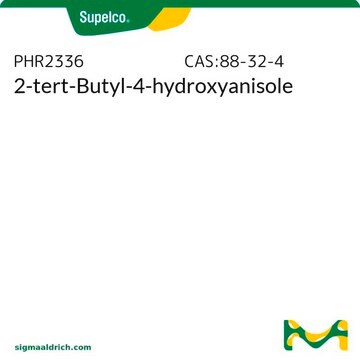PHR1306
3-tert-Butyl-4-hydroxyanisole
Pharmaceutical Secondary Standard; Certified Reference Material
Synonym(s):
2-tert-Butyl-4-methoxyphenol, 3-BHA, BHA
About This Item
Recommended Products
grade
certified reference material
pharmaceutical secondary standard
Quality Level
Agency
traceable to USP 1083100
API family
bha
CofA
current certificate can be downloaded
technique(s)
HPLC: suitable
gas chromatography (GC): suitable
application(s)
pharmaceutical (small molecule)
format
neat
storage temp.
2-30°C
SMILES string
COc1ccc(O)c(c1)C(C)(C)C
InChI
1S/C11H16O2/c1-11(2,3)9-7-8(13-4)5-6-10(9)12/h5-7,12H,1-4H3
InChI key
MRBKEAMVRSLQPH-UHFFFAOYSA-N
Looking for similar products? Visit Product Comparison Guide
General description
3-tert-Butyl-4-hydroxyanisole is a synthetic antioxidant, widely used as a food additive to prevent oxidative deterioration of fats and oils.
Application
Analysis Note
Other Notes
Footnote
Recommended products
related product
Hazard Statements
Precautionary Statements
Hazard Classifications
Aquatic Chronic 2
Storage Class Code
11 - Combustible Solids
WGK
WGK 2
Flash Point(F)
Not applicable
Flash Point(C)
Not applicable
Choose from one of the most recent versions:
Already Own This Product?
Find documentation for the products that you have recently purchased in the Document Library.
Customers Also Viewed
Our team of scientists has experience in all areas of research including Life Science, Material Science, Chemical Synthesis, Chromatography, Analytical and many others.
Contact Technical Service











